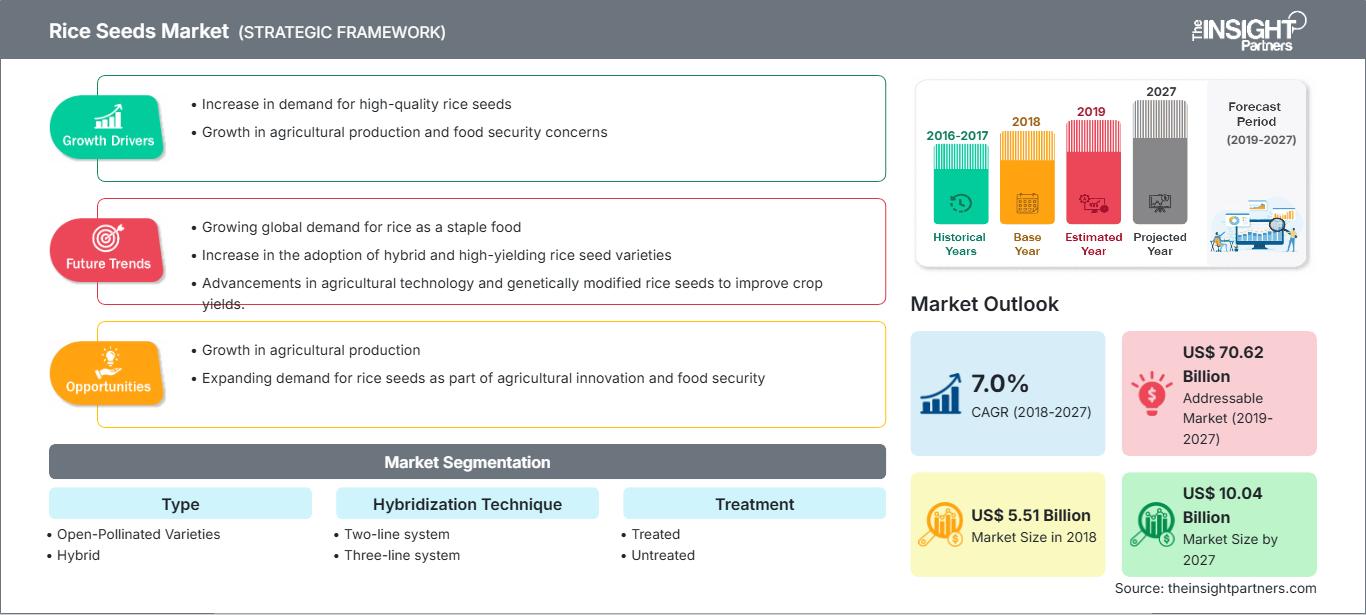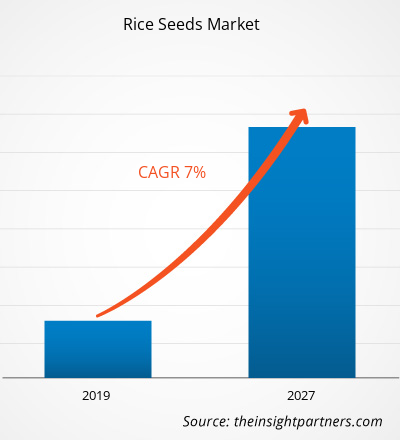2018 年水稻种子市场价值为 55.068 亿美元,预计到 2027 年将达到 100.36 亿美元;预计 2019 年至 2027 年的复合年增长率为 7.0%。
水稻是许多主要国家/地区的主食,尤其是在亚太地区。水稻种子,也称为稻谷,是完整的稻种,一粒稻谷包含一个米粒。它是 Oryza glaberrima 或 L. Oryza sativa 种子。此外,水稻种子还可用作生物反应器,生产肽或治疗性蛋白质等人类药物。预计亚太地区的水稻种子市场在预测期内将以最高的复合年增长率增长。该地区市场的增长主要归因于高人口密度,并且人口密度不断增长,尤其是在印度和中国等国家。此外,亚洲国家约有四分之一的人口属于贫困人口。预计这些国家将推动亚太地区的大米消费。然而,像日本和韩国这样收入较高的国家,人均大米消费量却开始下降。人口持续增长和种植面积短缺是全球水稻种子市场亟待解决的两大主要问题。为了满足亚太地区日益增长的需求,迫切需要提高水稻种植的生产力。
自定义此报告以满足您的要求
您将免费获得任何报告的定制,包括本报告的部分内容,或国家级分析、Excel 数据包,以及为初创企业和大学提供超值优惠和折扣
水稻种子市场: 战略洞察

-
获取本报告的主要市场趋势。这个免费样本将包括数据分析,从市场趋势到估计和预测。
随着世界人口的增长,预计未来几年对大米的需求将会上升,以满足日益增长的粮食消费。然而,由于水和土地资源有限,水稻产量的增长对农民来说是一个挑战。解决这个问题的唯一办法是提高水稻种子的生产力。在过去的几年里,世界一些地区的水稻产量停滞不前或下降,主要是由于水稻单产潜力的提高不大。杂交种子的开发为各国提高水稻生产力和实现水稻生产自给自足提供了解决方案。分子生物学、生物技术和基因组学领域的技术进步日益显著,导致了杂交水稻育种的重大改进。此外,杂交水稻种子生产领域持续的研发投入和公私合作 (PPP) 趋势的上升,进一步导致了杂交种子的采用率不断提高,尤其是在商业农民中。预计所有这些因素都将在预测期内推动杂交种子的需求。
类型洞察
根据类型,水稻种子市场分为开放授粉品种和杂交品种。开放授粉品种 (OPV) 水稻种子是通过亲本植物自然授粉而产生的。此类授粉方法包括自花授粉以及通过昆虫、鸟类和其他自然方式授粉。与杂交种子不同,这些种子产生的植株与亲本植物完全相同,在某些情况下被称为标准品种。OPV 的选择取决于种植者的需求。如果能够有效地维护和生产,OPV 在繁殖过程中会保留相同的特性。OPV 水稻种子表现出更多的遗传多样性,因为它们会根据一个地区的生长条件和气候缓慢地适应。商业种植者更喜欢杂交种子而不是 OPV,以获得高产量和某些所需的特性。虽然杂交种子比 OPV 有一些优势,但 OPV 有助于保护植物的遗传多样性。全球对天然种植水稻和其他食品的需求不断增长,预计将在未来几年推动口服脊髓灰质炎病毒(OPV)市场的发展。
杂交技术洞察
根据杂交技术,水稻种子市场分为两系系统和三系系统。两系系统在2018年占据了最大的市场份额。两系杂交品种的优点包括无需保持系、在培育杂种优势品种时亲本选择范围广泛以及不受不育细胞质的负面影响。两系杂交种子的总体生产与三系杂交品种差别不大。两系杂交种子生产的一个重要考虑因素是确定合适的地点或季节。预计双系系统的优势将在预测期内推动双系杂交品种的需求。
水稻种子市场的一些参与者包括 BASF SE、Bayer AG、DuPont de Nemours, Inc.、Guard Rice Mills、Kaveri Seeds、Mahyco、Nuziveedu Seeds Limited、Rallis India Limited、Rasi Seeds (P) Ltd. 和 SL-Agritech 等。关键公司实施并购和研发战略,以扩大客户群并在全球市场上获得显著份额,这也使他们能够在全球范围内维护自己的品牌。
报告重点
- 水稻种子市场的渐进式行业趋势,帮助参与者制定有效的长期战略
- 发达市场和发展中市场采用的业务增长战略
- 2019 年至 2027 年水稻种子市场的定量分析
- 全球水稻种子需求估计
- PEST 分析以说明行业中买家和供应商的效力
- 了解竞争激烈的市场形势
- 市场趋势和前景以及推动和抑制水稻种子市场增长的因素
- 通过强调支撑商业利益的市场策略来协助决策过程,从而促进市场增长
- 不同节点的水稻种子市场规模
- 详细市场概况和细分,以及水稻种子行业动态
- 各地区水稻种子市场规模及增长潜力
水稻种子市场区域洞察
The Insight Partners 的分析师已详尽阐述了预测期内影响水稻种子市场的区域趋势和因素。本节还讨论了北美、欧洲、亚太地区、中东和非洲以及南美和中美洲的水稻种子市场细分和地域分布。
水稻种子市场报告范围
| 报告属性 | 细节 |
|---|---|
| 市场规模 2018 | US$ 5.51 Billion |
| 市场规模 2027 | US$ 10.04 Billion |
| 全球复合年增长率 (2018 - 2027) | 7.0% |
| 历史数据 | 2016-2017 |
| 预测期 | 2019-2027 |
| 涵盖的领域 |
By 类型
|
| 覆盖地区和国家 |
北美
|
| 市场领导者和主要公司简介 |
|
水稻种子市场参与者密度:了解其对商业动态的影响
水稻种子市场正在快速增长,这得益于终端用户需求的不断增长,而这些需求的驱动因素包括消费者偏好的转变、技术进步以及对产品优势的认知度的提升。随着需求的增长,企业正在扩大产品线,不断创新以满足消费者需求,并抓住新兴趋势,从而进一步推动市场增长。

- 获取 水稻种子市场 主要参与者概述
- 开放授粉品种 (OPV)
- 杂交
水稻种子市场 - 按杂交技术
- 两系系统
- 三系系统
水稻种子市场 - 按处理
- 处理
- 未处理
水稻种子市场 -按颗粒大小分类
- 长粒
- 中粒
- 短粒
公司简介
- 巴斯夫公司
- 拜耳公司
- 杜邦公司
- Guard Rice Mills
- Kaveri Seed Company Ltd
- Maharastra Hybrid Seeds Company Private Limited (Mahyco)
- Nuziveedu Seeds Ltd. (NSL)
- Rallis India Limited
- Rasi Seeds (P) Ltd.
- SL Agritech Corporation
- 历史分析(2 年)、基准年、预测(7 年)及复合年增长率
- PEST和SWOT分析
- 市场规模、价值/数量 - 全球、区域、国家
- 行业和竞争格局
- Excel 数据集
近期报告
相关报告
客户评价
购买理由
- 明智的决策
- 了解市场动态
- 竞争分析
- 客户洞察
- 市场预测
- 风险规避
- 战略规划
- 投资论证
- 识别新兴市场
- 优化营销策略
- 提升运营效率
- 顺应监管趋势






















 获取免费样品 - 水稻种子市场
获取免费样品 - 水稻种子市场